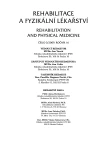Postural Strategy in the Course of Motor Development
Authors:
K. Faladová; T. Nováková
Authors‘ workplace:
Katedra fyzioterapie FTVS UK, Praha
vedoucí katedry doc. PaedDr. D. Pavlů, CSc.
Published in:
Rehabil. fyz. Lék., 16, 2009, No. 3, pp. 116-119.
Category:
Original Papers
Overview
Background:
The present tests used for evaluation of motor development are not adequate for physiotherapist requiremnents. They are especially lacking qualitative evaluation of motor skills.
Methods:
The paper analyzes theoretical knowledge concerning the new view of evaluating postural maturity and quality of movements in the course of ontogenesis of motor skills in children of toddler and preschool age. The contribution is aimed to analyze the problems of testing maturity of gross motor skills at early child age from the standpoint of neurophysiology, biocybernetics and kinesiology. The attention is particularly devoted to evaluating the ability of motion differentiation.
Conclusions:
The ability of motion differentiation and intersegmental coordination depends on the level of coactivation of all control mechanisms participating in the resultant intentional motion. It represents the means suitable for qualitative evaluation of motor manifestation.
Key words:
postural strategy, motor development, motion differentiation
Sources
1. ASSAIANTE, CH., MALLAU, CH.: Development of postural kontrol in healthy children:a functional approach. Neural Plasticity, 12, 2005, č. 2, s. 109-118.
2. AZEVEDO, CH., ESPIAU, B.: Bipedal locomotion:tovard unified concepts in robotics and neuroscience. Biological Cybernetics, 96, 2007, č. 3, s. 209-228.
3. LATASH, L. M.: Neurophysiological basis of movement. Humankinetics, 2008. ISBN-10:0-7360-6367-6.
4. MALLAU, S., MESURE, S.: Locomotor skilland balance strategie in children with internal rotations of the lover limbs. Journal of Orthopeadic Research, 26, 2008, č. 2, s. 117-125.
5. PIEK, J. P.: Infant motor development, Humankinetics, 2006, 323 s.
6. SCHMITZ, CH.: Building anticipatory postural adjustment dutiny childhood: a kinematic and electromyographic analysis of unloading in children from 4-8 years of age. Experimental Brain Research, 96, 2002, č. 3, s. 354-364.
7. VOJTA, V., PETERS, A.: Vojtův princip. Grada, 1995, 181 s.
Labels
Physiotherapist, university degree Rehabilitation Sports medicineArticle was published in
Rehabilitation & Physical Medicine

2009 Issue 3
- Hope Awakens with Early Diagnosis of Parkinson's Disease Based on Skin Odor
- Deep stimulation of the globus pallidus improved clinical symptoms in a patient with refractory parkinsonism and genetic mutation
Most read in this issue
- Postural Strategy in the Course of Motor Development
- The Problem of Postoperative Stump in Patients with Transtibial Amputation as Viewed by Physiotherapist, Biomechanic and Prosthetic Specialists
- Possible Compensation of Constitutive Hypermobility by Exercise in the Fitness Center
- Therapeutic Solution of Lateral Instability of Astragalus Ligaments
